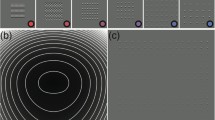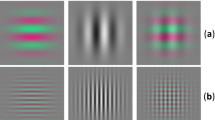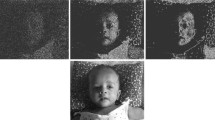Abstract
Threshold contrasts were determined for complex gratings made from pairs of sine-wave gratings with various spatial frequencies and contrast ratios. It was found that the plots representing the relationship between the contrast of two-component gratings with frequencies f 1=2.0 deg−1 and f 2=kf 1, (1.03 ⩽ k ⩽ 3.0), when the compound was at threshold (the so-called contrast threshold curves), tend to have either an elliptical (for k ⩽ 1.5) or a rectangular (for k=3) form. Nevertheless, the elliptical fits as the matched-channel model predicted, and the roundedly rectangular fits, as the probability-summation models predicted, were very poor. Furthermore, statistical analysis shows that two of the six contrast threshold curves exhibiting a significant local disturbance fail to be convex.Theoretical treatment in terms of convex analysis shows that such a convexity violation of the contrast threshold curves rules out the possibility of detection being produced by a single linear channel as well as a parallel array of linear channels, either with or without probability summation, provided that the detection principle of the most sensitive channel is adopted. The adaptive matched-channel model originally proposed by Hauske cannot also account for the results obtained; however, it can be modified to be in line with them. We hypothesise that the detection in our experiment is likely to occur by means of several (no more than seven or eight) adaptive partially matched channels.
Similar content being viewed by others
References
Blackwell HR (1963) Neural theories of simple visual discriminations. J Opt Soc Am 36:129–160
Blackwell HR, Chiou W, Blackwell BR (1978) Current status of research on the spatial organization of the human visual system at detection threshold. In: Cool SJ, Smith EL III (eds) Frontiers in visual science. Springer, Berlin Heidelberg New York, pp 264–276
Blommaert FJJ, Heynen GM, Roufs JAJ (1987) Point spread functions and detail detection. Spatial Vision 2:99–115
Bobrowski L (1982) Rules of forming receptive fields of formal neurones during unsupervised learning processes. Biol Cybern 43:23–28
Caelli T, Rentschier I, Scheidler W (1987) Visual pattern recognition in humans. I. Evidence for adaptive filtering. Biol Cybern 57:233–240
Campbell FW, Robson JG (1968) Application of Fourier analysis to the visibility of gratings. J Physiol (Lond) 197:551–556
Campbell FW, Carpenter RHS, Levinson JZ (1969) Visibility of aperiodic pattern compared with that of sinusoidal gratings. J Physiol (Lond) 204:283–298
Graham N (1977) Visual detection of aperiodic spatial stimuli by probability summation among narrowband channels. Vision Res 17:637–652
Graham N (1980) Spatial-frequency channels in human vision: detecting edges without edge detectors. In: Harris CS (eds) Visual coding and adaptability. Erlbaum, Hillsdale, NJ, pp 215–262
Graham N (1985) Detection and identification of near-threshold visual patterns. J Opt Soc Am [A] 2:1468–1482
Graham N (1989) Visual pattern analyzers. Clarendon Press, Oxford
Graham N, Nachmias J (1971) Detection of grating patterns containing two spatial frequencies: a comparison of single-channel and multiple-channel models. Vision Res 11:251–259
Graham N, Robson JG (1987) Summation of very close spatial frequencies: the importance of spatial probability summation. Vision Res 27:1997–2007
Graham N, Robson JG, Nachmias J (1978) Grating summation in fovea and periphery. Vision Res 18:815–825
Hauske G, Wolf W, Lupp U (1976) Matched filters in human vision. Biol Cybern 22:181–188
Hauske G, Lupp U, Wolf W (1978) Matched filters. A new concept in vision. Photogr Sci Eng 22:59–64
Hubel DH (1988) Eye, brain and vision. Scientific American, New York
Koenderink JJ, Doom AJ van (1978) Detectability of power fluctuations of temporal visual noise. Vision Res 18:191–195
Kulikowski JJ, King-Smith PE (1973) Spatial arrangement of line edge and grating detectors revealed by subthreshold summation. Vision Res 13:1455–1478
Limb JO, Rubinstein CB (1977) A model of threshold vision incorporating inhomogeneity of the visual field. Vision Res 21:1409–1412
Lloyd E (ed) (1984) Statistics. (Handbook of applicable mathematics, vol. 6 Part A), Wiley, Chichester
Logvinenko AD (1985) Sensory basis of space perception (in Russian). Moscow University Press, Moscow
Logvinenko AD (1990) Nonlinear analysis of spatial vision using first-and second-order Volterra transfer functions measurement. Vision Res 30:2031–2057
Logvinenko AD (1991) Failure of convexity of contrast threshold curves. Preception 20:82
Matin L (1975) Ricco's law: response as a power function of stimulus luminance and distance from target center. Vision Res 15:1381–1384
Mortensen U (1988) Visual contrast detection by a single channel versus probability summation among channels. Biol Cybern 59:137–147
Mostafavi H, Sakrison DJ (1976) Structure and properties of a single channel in the human visual system. Vision Res 16:957–968
Mullins WW (1978) Convexity theorem for subthershold stimuli in linear models of visual contrast detection. J Opt Soc Am 68:456–459
Olzak LA, Thomas JP (1986) Seeing spatial patterns. In:Boff KR, Kaufman L, Thomas JP (eds) Sensory processes and perception. (Handbook of perception and human performance, vol 1, Chap. 7) Wiley, New York
Quick RF Jr (1974) A vector-magnitude model of contrast detection. Kybernetik 16:65–67
Quick RF Jr, Reichert TA (1975) Spatial-frequency selectivity in contrast detection. Vision Res 15:637–643
Quick RF Jr, Mullins WW, Reichert TA (1978) Spatial summation effects on two-component grating thresholds. J Opt Soc Am 68:116–121
Rashbass C (1970) The visibility of transient changes of luminance. J Physiol (Lond) 210:165–186
Sachs MB, Nachmias J, Robson JG (1971) Spatial-frequency channels in human vision. J Opt Soc Am 61:1176–1186
Thomas JP (1985) Detection and identification: how are they related? J Opt Soc Am [A] 2:1457–1467
Tsypkin Ya Z (1973) Foundation of the theory of learning systems. Academic Press, New York
Watson AB (1982) Summation of grating patches indicates many types of detector at one retinal location. Vision Res 22:17–25
Watson AB, Nachmias J (1977) Patterns of temporal interaction in the detection of gratings. Vision Res 17:893–902
Watson AB, Robson JG (1981) Discrimination at threshold: labelled detectors in human vision. Vision Res 21:1115–1122
Wiener N (1932) Tauberian theorems. Ann Math 33:1–100
Wilson HR, Bergen JR (1979) A four mechanism model for threshold spatial vision. Vision Res 19:19–32
Author information
Authors and Affiliations
Rights and permissions
About this article
Cite this article
Logvinenko, A.D. Lack of convexity of threshold curves for compound grating: implications for modelling visual pattern detection. Biol. Cybern. 70, 55–64 (1993). https://doi.org/10.1007/BF00202566
Received:
Accepted:
Issue Date:
DOI: https://doi.org/10.1007/BF00202566




